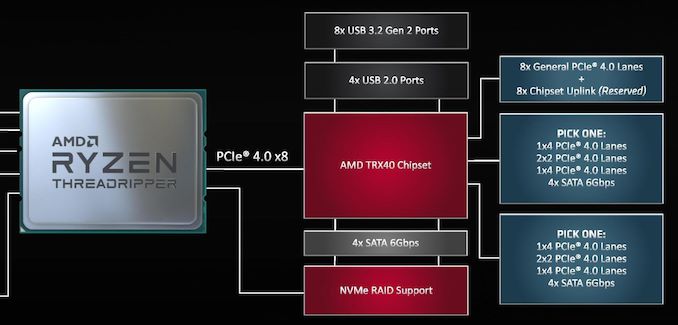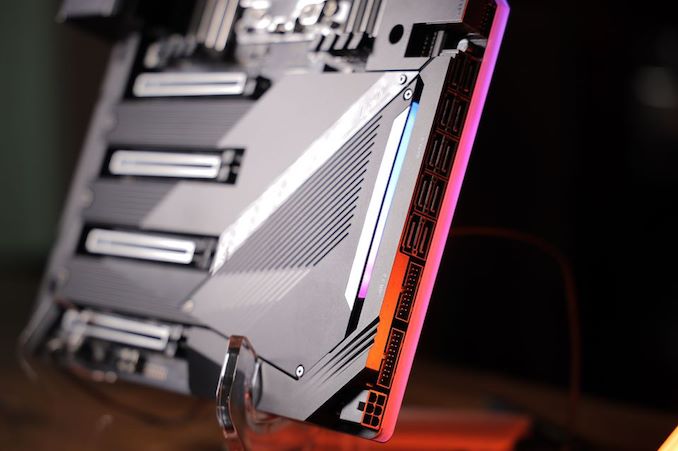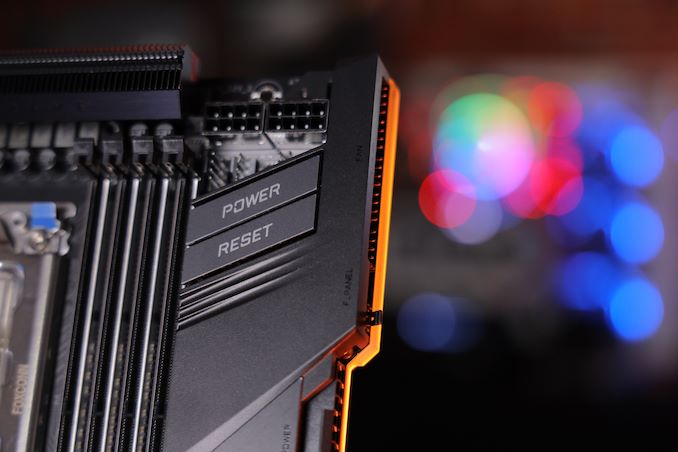AMD Q4: 16-core Ryzen 9 3950X, Threadripper Up To 32-Core 3970X, Coming November 25th
by Dr. Ian Cutress on November 7, 2019 9:00 AM ESTTRX40: More High-End Motherboards for TR3
The new sTRX4 socket will be paired with a TRX40 chipset – a design that AMD says comes from an in-house team and built on GlobalFoundries 14nm. The new chipset, updated from the previous X399 in this space and even updated from the X570 in the consumer space, is the other half in the CPU-to-chipset bandwidth story. By using a PCIe 4.0 x8 link, AMD is removing almost any practical bandwidth limitation downstream from the CPU.
The new TRX40 chipset will come with a degree of modularity.
From the chipset, we can see motherboard manufacturers afforded a full PCIe 4.0 x8 slot, up to another x8 lanes as two x4 connections or further bifurcated, or instead of those bifurcated lanes, either four or eight more SATA ports. That’s 8 SATA ports on top of the four already present on the chipset.
So I like these modular systems. It allows motherboard manufacturers to go crazy with offering potential systems. For example:
| Potential TRX40 Variants | |||||||
| AnandTech | CPU | Chipset | |||||
| TRX40 SATA Powerhouse 20 drives |
x48 for PCIe slots | x8 for downlink | 8x SATA from options | x8 for dual NVMe | 8x SATA from options | 4x SATA from chipset | |
| TRX40 NVMe Powerhouse 18+ drives |
x48 for PCIe slots | x8 for downlink | dual NVMe from options | x8 for dual NVMe | dual NVMe for options | - | |
So that would be a motherboard with x16/x16/x16 (or x16/x8/x16/x8) in terms of PCIe 4.0 slots, a single x8 slot for a pair of NVMe drives, and then TWENTY SATA ports, all directly supported on the system without any additional controllers.
If SATA isn’t your thing, then the same arguments could be made for 48 PCIe lanes and six PCIe 4.0 x4 NVMe slots, making a total of 18 high capacity PCIe 4.0 drives. The fact that AMD has put more PCIe lanes into their high end desktop platforms, plus this amount of modularity, wants me to play Dr. Frankenstein.
To be fair, those ideas are a bit extreme. Motherboard manufacturers will likely have to partition off a few lanes for 10 GbE networking, perhaps Thunderbolt, or maybe something more exotic like a RAID controller, or an RGB controller.
As noted in some of our previous news posts, motherboard manufacturers have been slowly leaking names of their TRX40 products. At this point in time we have seen mentions of the following:
- ASRock TRX40 Creator
- ASRock TRX40 Taichi
- GIGABYTE TRX40 AORUS XTREME
- ASUS Prime TRX40 Pro
- ASUS ROG Zenith II Extreme
- MSI TRX40 Creator
- MSI TRX40 Pro 10G
- MSI TRX40 Pro Wi-Fi
We expect details of some of these to perhaps be announced today, or on the 25th when the CPUs come to market. GIGABYTE has even been showing previews of their motherboards on social media, with one showing an obscene number of power phases, and we’ve seen images of boards with 8 SATA ports. We’ll have our usual motherboard overview article up on that date, and we’ll be looking at reviews of these motherboards through the new year.
I will address comments about potential TRX80/WRX80 motherboards which have been put into the ether as potential other chipsets being launched. When asked, AMD said that the only chipset they are launching today is TRX40.













171 Comments
View All Comments
Korguz - Thursday, November 7, 2019 - link
airdrifting looks like you still need to be told, intels TDP is at BASE clock, WITH OUT turbo, and WILL use more power even with " runs turbo out of the box by default "airdrifting - Friday, November 8, 2019 - link
What's the point of TDP at a "base clock" that the processor never runs at? Please allow me to put this in a language even you can understand: You brag you can last 30 minutes when in fact you only last 20 seconds, when girls call out you bs you claim "oh my 30 minute record was done when I was given superman power." Now here comes the question: Do you last 20 seconds or 30 minutes in reality?Korguz - Friday, November 8, 2019 - link
" What's the point of TDP at a "base clock" that the processor never runs at " cause thats where intel gets its TDP spec from, which IS from the BASE clock, Anandtech even did an article on this here : https://www.anandtech.com/show/13544/why-intel-pro... i would suggest you read this. then maybe you would actually understand.2nd GROW UP. the fact you now resort to insults, further shows you know you are wrong, and you have to resort to a VERY childish analogy.
Korguz - Friday, November 8, 2019 - link
and i quote from the above link to the Anandtech article :" For any given processor, Intel will guarantee both a rated frequency to run at (known as the base frequency) for a given power, which is the rated TDP. This means that a processor like the 65W Core i7-8700, which has a base frequency of 3.2 GHz and a turbo of 4.7 GHz, is only guaranteed to be at or below 65W when the processor is running at 3.2 GHz. Intel does not guarantee any level of performance above this 3.2 GHz / 65W value. "
airdrifting - Friday, November 8, 2019 - link
Yeah, I see you are not capable of reading. Done.Korguz - Friday, November 8, 2019 - link
more like you are not capable of reading... and proves you are wrong.. your pride to high to admit it ?? the quote from the article, alone, proves you are wrong.. nuff said..Irata - Friday, November 8, 2019 - link
The point is simply to be able to have "95W" shown next to the CPU in a benchmark slide while the performance result is based on "far beyond 95W" clock speeds.This was not the case with Intel's pre Ryzen CPU like the 7700k btw. Go figure why this has changed.
eddman - Friday, November 8, 2019 - link
And? They never claimed the processors could do turbo within the TDP. It's based on the base clock and obviously any turbo will use more power. That's how they've always rated TDP. It's been known for years. Turbo have always been a "bonus". If the board can supply enough power and the temps are low enough, then it'd clock higher. Simple as that.eddman - Friday, November 8, 2019 - link
@Ian Will the website ever upgrade to a better commenting system?I was replying to airdrifting.
Father Time - Sunday, November 24, 2019 - link
So based on this, AMD could claim their processors are all 1 Watt - based on course on a 200mhz super-low C-State - but still true that they consume 1 Watt at this speed.The fact it will never run at this power or speed is irrelevant, they could use the Intel system to the extreme to claim the performance crown with a 1 Watt processor - everything above 200mhz is just a bonus!